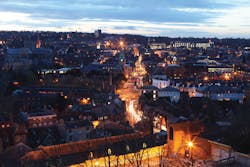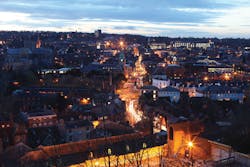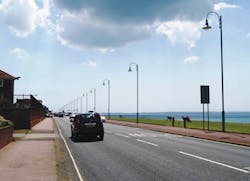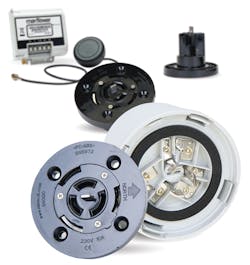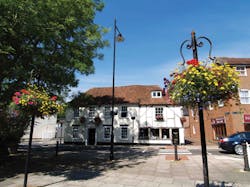Remember when lights were for illumination? Hampshire's 155,000 Internet-connected LED luminaires stand to do much, much more, reports MARK HALPER. They might even direct traffic, monitor air quality, and tell visitors what's on in the cities.
Wind your way along the highways of Hampshire, England, and chances are the street lights won't stand out to you as anything other than, well, street lights. They might look equally innocuous if you happen to be strolling through some of the county's urban centers such as the port city of Southampton, or Winchester, home to the famous cathedral.
Interested in articles & announcements on smart street lighting?
But look closely, and something is changing. It's not just that the luminaires no longer give off the yellowish glow of the former low-pressure sodium (LPS) lamps. No, that's old news. Hampshire started replacing its LPS lights in 2010 with a mix of whiter light sources including LEDs, high-pressure sodium (HPS), fluorescent, and others. It was part of a huge energy-and-cost savings push that included a new wireless central management system (CMS) in which operators could not only turn lights on and off remotely, but could also dim and brighten them and monitor outages from a central point without dispatching watchmen.
But now, with the CMS infrastructure already in place tying 155,000 street lamps into a ZigBee wireless mesh information technology network installed originally for controlling and monitoring the light levels, those same lights and the furnishings that house them are poised to become much more than sources of illumination.
Hampshire, a county of about 1.3 million people southwest of London and stretching down to the English Channel, is on the vanguard of lighting's future. The network of lights is beginning to double as an information technology network in which sensors embedded among the lighting hardware are taking note of data points like traffic and parking conditions, crowds, air quality, road surfaces, and others that, when delivered through the network and into the right hands, could help the county improve and slash the cost of many services and operations.
Winchester is trialing lamppost-mounted Bluetooth iBeacons to send "what's on" and other information to visitors' smartphones. The city updates the data via a wireless ZigBee mesh network that connects the street lights.(Source: Mayflower via iStock: © merlinpf.)
Western Europe is already a leader in connected outdoor lighting, as Strategies Unlimited analyst Shonika Vohra reported in LEDs Magazine last September. This county is a prime, early example of the fledgling Internet of Things (IoT) movement to use the street-light system to underpin smart cities and other intelligent, network-connected public areas.
"We created a huge network around the county of Hampshire and its towns and cities and so on," noted Patrick Mitchell, managing director at Mayflower Complete Lighting Control, the subsidiary of SSE Enterprise, a division of utility SSE plc which won the lighting replacement job in Hampshire in 2009. "And we can use that network for other things. The primary goal was to control, maintain, and monitor street lighting. But now we're asking, 'What else can we do with it?'"
Engineer Richard Sims couldn't agree more. "The business case in the beginning was the lighting and the energy savings," noted Sims, senior consultant at The Technology Partnership (TTP), the Hertfordshire, England-based engineering company that is the lead technology consultant to Mayflower. "But once you have this network installed, you can leverage it for other stuff. We are trying to find ways."
Pondering the possibilities
Sims and Mitchell will be the first to say that they are still in the early stages of formulating and trialing ideas, none of which are yet in widespread practice across the county, but some of which are in a small pilot phase. Many of the test schemes deploy sensors from Zaragoza, Spain-based Libelium, and in some cases they are designed to feed into a cloud data system via an open-source system called Sentilo, developed primarily by the Barcelona City Council but which has other contributors.
In some instances, Hampshire itself is helping Mayflower and TTP to fund certain smart city applications. For example, Hampshire is equipping light poles in popular areas of Winchester with Bluetooth iBeacons that transmit information to smartphones about events in the city. Hampshire uses the existing ZigBee network to update and refresh the information, and then pushes it to users' phones and other gadgets via Bluetooth. Although the Winchester installation is just a trial, Mitchell envisions it possibly catching on as a popular system in which retailers might want to participate, thus representing a possible monetization of the system, as long as end users opt in.
Smart street lights line the seafront at Lee-on-the-Solent, west of Portsmouth on the Solent strait.(Source: Mayflower.)
And in Southampton, the city council is trialing a system that uses Libelium sensors to detect air quality, taking note of CO2 emissions and various pollutants such as carbon monoxide and nitrogen dioxide. While costly equipment exists today to note such data points in great detail, Sims suspects that there might be a use and market for far less expensive sensor-based gear to provide a useful, if less detailed, level of information.
"The sensors can attach to anything," said Sims. "They happen to be attached to the light posts at the moment, because it's a relatively sensible place to put them. You can effectively deploy them wherever there's a Mayflower radio network, which is pretty much everywhere there's a main road in Hampshire."
Traffic analysis
Mayflower - which is in the process of changing its name to Mayflower Smart Control - and TTP are also trialing other uses on their own dime. For example, they see great potential for a computer-vision system from New York City-based Placemeter that analyzes images from rudimentary cameras - mounted on lighting fixtures or elsewhere - to provide detailed information about traffic flow. By applying algorithms to the images, the Placemeter system notes not only how many or how few vehicles and people are on a road, but can also describe them as trucks, cars, motorcycles, bikes, pedestrians, and so forth. The system does not send the actual images anywhere. If it did, that would come with privacy concerns, noted Sims. Rather, the system sends data scrubbed from the images, so the right authorities can make decisions about road changes, traffic alerts, and the like.
Mayflower makes lighting controls for highways, main roads, high masts, parking lots, and other lighting environments.(Source: Mayflower.)
TTP and Mayflower are currently kicking the tires on that system in parking lots and other property owned by Mayflower's parent company, SSE, in Portsmouth, Sims said.
For Sims' TTP and Mitchell's Mayflower, the trials and potential for smart, Internet-connected lighting in Hampshire touches on one of the biggest questions surrounding the future of lighting-based, smart city infrastructure: Who really needs the information that the world's luminaires collect, and who is willing to pay for it? At Strategies in Light Europe and LuxLive last fall, who owns the data and how it should be used was a significant source of controversy and discussion.
Romsey is a quaint old market town that traces its origins back before Norman times. Its modern touches include digitally controlled street lighting, even if the fittings have a classic look. (Source: Mayflower.)
Mulling the monetization
"The capturing of the data is in some ways the easy part," said Sims. "We're trying to work out how to monetize this. There's no point in capturing the data for the sake of it. It has to be giving something useful."
For instance, he noted that the pollutant system might not be an easy sell, because the UK government's Department of Environment, Food and Rural Affairs (DEFRA) already operates elaborate environmental monitoring stations. But, he said, those cost on the order of £200,000 (about $246,000), while sensors from Libelium cost less than £1000 (about $1229) and can potentially provide a useful, if not as complete, set of readings.
"There's a compelling financial argument there," said Sims. "There is a kind of ongoing process to try to work out whether the environmental data is accurate enough to supplement or replace the high-end DEFRA stuff. If it isn't, is it good enough to give you, at the very least, an idea of relative changes in air quality? Maybe all you need to detect is whether there are high amounts or low amounts of nitrogen dioxide, for example. Maybe that's good enough."
Neither the vendor community - such as TTP and Mayflower - nor government entities such as Hampshire County Council yet know exactly what the killer apps will be for networked, connected street lighting.
"Predominantly, it's mainly trials at the moment, in part because local councils don't seem to know what they require," said Mitchell. He suspects, though, that traffic analysis might emerge as a popular use for local governments. It could be something as simple as counting cars. "Right now, it's student and old-age pensioners [senior citizens] with clickers, in deck chairs," he quipped. Using the existing street lighting network for such a purpose would be just one example of how the existing wirelessly controlled set of street lights could "form the backbone of a connected city," he noted.
"We just don't necessarily understand yet what information councils find useful and are willing to pay for," added Sims.
Indeed, counties and cities around the world are mulling novel uses for smart, sensor-equipped street lighting. The city of Bristol, England thinks it might be able to slash the cost of winter road maintenance by outfitting light poles with sensors that note road surface temperature and deliver precise information to salting crews about which roads and sections of the city require costly salting, and which do not. Today, many cities dispatch salt trucks to blanket an entire city or region, rather than dispatching them only to the sections where they are needed. Bristol, regarded as a green-minded city, at one point was considering using sensors that detect birdsong and thus track migratory patterns across its urban areas and parklands. In the US, GE's new energy and lighting group - called Current, powered by GE - a year ago teamed with a company called ShotSpotter to outfit streetlights to detect gunshots and alert the police.
Data dilemma
The list of possibilities is as big as the imagination. One issue, though: To what extent should any data that the systems collect be for sale versus free and open to the public?
"It depends a bit on the local authority," noted Sims. "There's a big move to 'open data,' which I think is a good thing. But there's an obvious conflict there between open data and monetizing the information. It depends on the local authority. Local authorities might make available aggregate data or time-delayed data for free. The way things seem to be going is if the council is paying for the installation of the infrastructure, they make the data free. I think that seems to be the sensible way of doing it. If you're a local authority, you've fundamentally paid for this stuff with public money. It's different if a private company is coming in and paying to install the network."
His thoughts make interesting food for thought as people ponder the extent to which cities in financially challenging times should fund and operate services themselves versus outsource or hand them off to private enterprise.
They also raise the possibility that, as Sims noted, cities themselves could become "good citizens" by providing digital services that enhance the daily lives of people living in, visiting, and using the metropolis, or in the case of Hampshire, the county. That, in turn, could help the local scene and economy to thrive. If that's what smart lighting helps to do, then clearly the 155,000 LED street lamps in Hampshire will be brightening up much more than the county's roadways, walkways, and parklands.
MARK HALPER is a contributing editor with LEDs Magazine ([email protected]).
